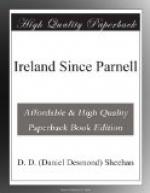Let it be, however, clearly understood that there was an Irish Party before Parnell’s advent on the scene. It was never a very effective instrument of popular right, but after Butt’s death it became a decrepit old thing—without cohesion, purpose or, except in rare instances, any genuine personal patriotism. It viewed the rise of Parnell and his limited body of supporters with disgust and dismay. It had no sympathy with his pertinacious campaign against all the cherished forms and traditions of “The House,” and it gave him no support. Rather it virulently opposed him and his small group, who were without money and even without any organisation at their back. Parnell had also to contend with the principal Nationalist newspaper of the time—The Freeman’s Journal—as well as such remnants as remained of Butt’s Home Rule League.
About this time, however, a movement—not for the first or the last time—came out of the West. A meeting had been held at Irishtown, County Mayo, which made history. It was here that the demand of “The Land for the People” first took concrete form. Previously Mr Parnell and his lieutenants had been addressing meetings in many parts of the country, at which they advocated peasant proprietorship in substitution for landlordism, but now instead of sporadic speeches they had to their hand an organisation which supplied them with a tremendous dynamic force and gave a new edge to their Parliamentary performances. And not the least value of the new movement was that it immediately won over to active co-operation in its work the most powerful men in the old revolutionary organisation. I remember being present, as a very little lad indeed, at a Land League meeting at Kiskeam, Cork County, where scrolls spanned the village street bearing the legend: “Ireland for the Irish and the Land for the People.”
The country people were present from far and near. Cavalcades of horsemen thronged in from many a distant place, wearing proudly the Fenian sash of orange and green over their shoulder, and it struck my youthful imagination what a dashing body of cavalry these would have made in the fight for Ireland. Michael Davitt was the founder and mainspring of the Land League and it is within my memory that in the hearts and the talks of the people around their fireside hearths he was at this time only second to Parnell in their hope and love. I am told that Mr John Devoy shared with him the honour of co-founder of the Land League, but I confess I heard little of Mr Devoy, probably because he was compulsorily exiled about this time.[1]
In those days Parnell’s following consisted of only seven men out of one hundred and three Irish members. When the General Election of 1880 was declared he was utterly unprepared to meet all its emergencies. For lack of candidates he had to allow himself to be nominated for three constituencies, yet with marvellous and almost incredible energy he fought on to the last polling-booth. The result




